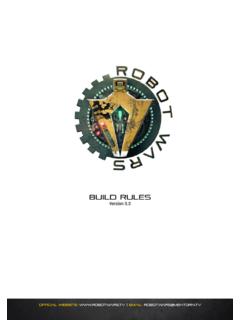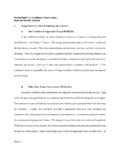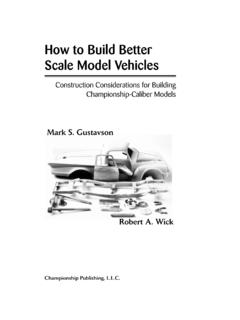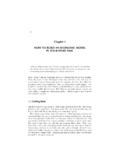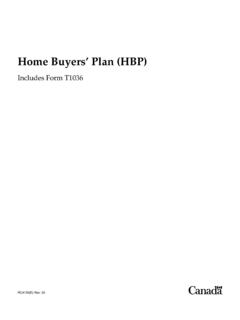Transcription of Final Regulations Effective May 1, 1997 As Amended April 4 ...
1 Final Regulations Effective May 1, 1997 . As Amended April 4, 2010. rules AND Regulations . FOR THE PROTECTION FROM CONTAMINATION, DEGRADATION. AND POLLUTION OF. THE NEW YORK CITY WATER SUPPLY AND ITS SOURCES. Final Regulations Effective May 1, 1997 . As Amended April 4, 2010. CHAPTER 18. rules OF THE CITY OF NEW YORK. SUBCHAPTER A GENERAL PROVISIONS .. 1. 18-11 Preface .. 1. 18-12 Purpose and Findings .. 1. 18-13 3. 18-14 Applicability .. 3. 18-15 Local Representatives .. 4. 18-16 Definitions .. 5. 18-17 References .. 20. SUBCHAPTER B STANDARDS AND PROCEDURES FOR REGULATED.
2 ACTIVITIES AND NONCOMPLYING REGULATED. ACTIVITIES .. 22. 18-21 Standards for Regulated Activities .. 22. 18-22 Procedures for Notification and/or Reporting .. 23. 18-23 Application Procedures and Requirements .. 23. 18-24 Emergency Procedures ..28. 18-25 Optional Pre-application Conference ..29. 18-26 Modification, Suspension or Revocation of Approvals and 30. 18-27 Noncomplying Regulated Activities .. 31. 18-28 Appeals .. 34. 18-29 Hearings on Cease and Desist 36. 18-30 State Environmental Quality Review Act (SEQRA) .. 37. SUBCHAPTER C REGULATED ACTIVITIES .. 38. 18-31 Pathogenic Materials.
3 38. 18-32 Hazardous Substances and Hazardous Wastes .. 38. 18-33 Radioactive Materials .. 39. 18-34 Petroleum Products .. 39. 18-35 Human Excreta and Holding 41. 18-36 Wastewater Treatment Plants .. 41. 18-37 Sewer Systems, Service Connections and Discharges to Sewer Systems .. 51. 18-38 Subsurface Sewage Treatment Systems .. 54. 18-39 Stormwater Pollution Prevention Plans and Impervious Surfaces .. 59. 18-40 Miscellaneous Point Sources .. 73. 18-41 Solid Waste .. 73. 18-42 Agricultural Activities .. 74. 18-43 Pesticides .. 74. 18-44 Fertilizers .. 74. 18-45 Snow Disposal and Storage and Use of Winter Highway Maintenance Materials.
4 75. i Final Regulations Effective May 1, 1997 . As Amended April 4, 2010. SUBCHAPTER D WATER QUALITY STANDARDS FOR. RESERVOIRS AND CONTROLLED LAKES .. 77. 18-48 Water Quality Standards .. 77. SUBCHAPTER E 18-51 79. SUBCHAPTER F VARIANCES .. 80. 18-61 Variances .. 80. SUBCHAPTER G ADMINISTRATION AND ENFORCEMENT. BY LOCAL GOVERNMENTS ..86. 18-71 Certification of Administrative Programs ..86. 18-72 Administrative 18-73 Annual Review of Administrative 18-74 Decertification or Modification of Administrative Programs ..88. 18-75 Certification of Enforcement Programs ..88. 18-76 Annual Review of Enforcement Programs.
5 89. 18-77 Decertification or Modification of Enforcement Programs ..90. 18-78 Consent of the City ..90. SUBCHAPTER H WATERSHED PROTECTION PLANS ..91. 18-81 Local Government Stormwater Protection Plans ..91. 18-82 Watershed Planning in the Croton System ..94. 18-83 Watershed Planning in the West of Hudson Watershed .. 102. 18-84 Permanent Phosphorus Offset Program .. 103. SUBCHAPTER I 105. 18-91 Severability ..105. APPENDICES. Appendix 18-A Watershed 106. Appendix 18-B System Specific Water Quality Characteristics .. 108. Appendix 18-C Tests for Analytical Determination of Concentrations of Elements.
6 110. ii Final Regulations Effective May 1, 1997 . As Amended April 4, 2010. SUBCHAPTER A. GENERAL PROVISIONS. 18-11 Preface. (a) The health, welfare and economic well-being of nearly nine million residents in the five counties of New York City ("the City"), and of an increasing number of upstate New York communities is inextricably tied to the quality of the source waters in the watersheds of the New York City Water Supply located in Westchester, Putnam, Dutchess, Delaware, Ulster, Greene, Sullivan and Schoharie Counties, and Fairfield County in Connecticut. The high quality of these waters faces a continuing threat from the cumulative and episodic impacts of pollution sources generated by certain land uses and activities in the watersheds.
7 It is the duty of the Commissioner of the New York City Department of Environmental Protection (the "Department") to protect the high quality of waters from which the City's water supply is drawn and preserve it from degradation for the purpose of protecting the health and general welfare of its consumers. (b) These rules and Regulations repeal in their entirety and supersede the rules and Regulations for the Department of Water Supply, Gas and Electricity of the City of New York enacted the 11th day of June, 1953. (c) These rules and Regulations are hereby enacted pursuant to the authority vested in the Commissioner of the Department of Environmental Protection, as set forth in 18-13.
8 18-12 Purpose and Findings. (a) The quality of the drinking water supplied to the City and upstate communities which draw from the New York City water supply depends primarily on the quality of the source waters which feed the reservoirs. The source waters and reservoirs are vulnerable to degradation and contamination from various sources and activities, including, but not limited to: (1) Wastewater discharges to surface water and groundwater;. (2) Urban, suburban, rural, mining, silvicultural and agricultural land use practices that result in nonpoint source runoff of pollution and/or in adverse changes in the natural rate at which water flows into and through a delineated drainage basin; and (3) Improper use, handling, storage, transport and/or disposal of substances, including but not limited to, hazardous substances, radioactive materials, pesticides, fertilizers, winter highway maintenance materials, solid wastes, and animal wastes.
9 1. Final Regulations Effective May 1, 1997 . As Amended April 4, 2010. (b) The Department finds that such sources and activities, either alone or in conjunction with any other related activities, may constitute a source of contamination to or degradation of the water supply, may cause a contravention of the State water quality standards set forth in 6 NYCRR Parts 701-705, and Subchapter D of these rules and Regulations , and may result in the impairment of the use of the water supply for drinking, culinary or food processing purposes. (c) In response to the Safe Drinking Water Act Amendments of 1986, the United States Environmental Protection Agency has begun implementing a significant expansion of regulatory requirements for public water systems.
10 In order to protect the public health, and to satisfy the legislative mandates of the Safe Drinking Water Act Amendments and the rules and Regulations in 40 CFR. Parts 141 and 142, the New York State Department of Health has Amended the State Sanitary Code, 10 NYCRR Part 5, Subpart 5-1, Public Water Systems, which contains New York State's Surface Water Treatment Rule. Although both Federal and State law propose filtration as a method for water quality treatment for pathogen control, the effectiveness of the filtration process and complexity of plant operation is dependent upon the quality of the water entering the filtration plant.










